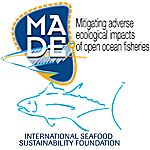An ecosystem approach to fisheries management is a widely recognized goal, but describing and measuring the effects of a fishery on an ecosystem is difficult. We used data from the well-documented purse-seine fishery for tunas in the eastern tropical Pacific Ocean to examine the fishery's ecological effects. Purse-seine fishing in the eastern tropical Pacific is conducted in 3 ways that differ in the amount and composition of target species and bycatch. The choice of method depends on whether the tunas are swimming alone (unassociated sets), associated with dolphins (dolphin sets), or associated with floating objects (floating-object sets). Among the fishing methods, we compared catch on the basis of weight, number of individuals, trophic level, replacement time and diversity. Floating-object sets removed 2-3 times as much biomass as the other 2 methods, depending on how removal was measured. Results of previous studies suggest the ecological effects of floating-object sets are thousands of times greater than the effects of other methods, but these results were derived from only numbers of discarded animals. Management of the fishery has been driven to a substantial extent by a focus on reducing bycatch, although discards are currently 4.8% of total catch by weight, compared with global averages of 7.5% for tuna longline fishing and 30.0% for midwater trawling. An ecosystem approach to fisheries management requires that ecological effects of fishing on all animals removed by a fishery, not just bycatch or discarded catch, be measured with a variety of metrics.
- Presentation

 PDF version
PDF version
